Download Centre

Looks like you don't have ESC button on your device
Download IronCAD DCS
Choose one of the following options
trial versionHas a license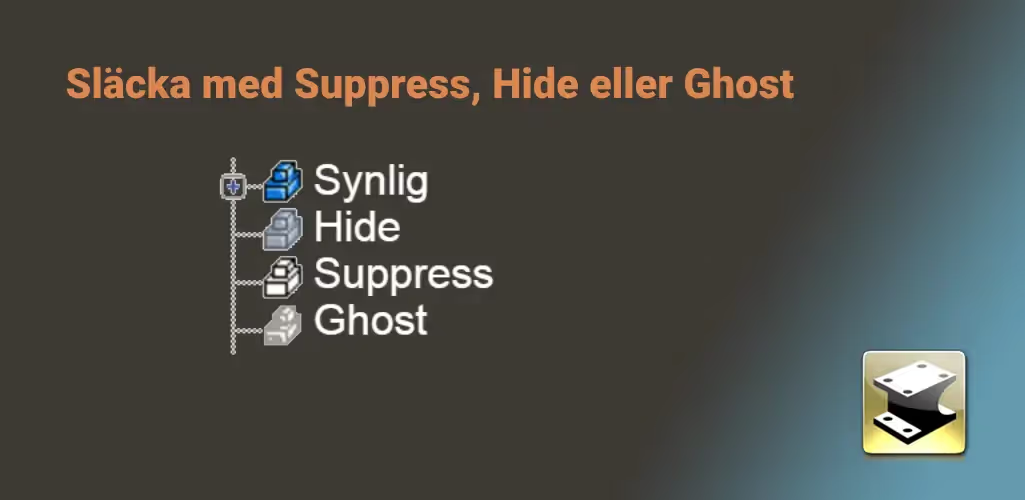

Emil Rindell

Jonas Bryntesson

Henrik Andersson
2025-02-04

Emil Rindell

Jonas Bryntesson

Henrik Andersson
2025-02-04
The Suppress function is intended to be used to hide objects in the 3D scene that should not be visible and when it should be so over a longer period of time. This also has a positive impact on performance as fewer objects are depicted on the screen and even the file size is reduced.
Tree icon
An object hidden via Suppress has a white icon in the tree.

Keep in mind that there are more alternatives to Suppress, see more info about this at the bottom of the article.

Suppress/Unsuppress
Suppress can be activated and deactivated via keyboard shortcut [K] on a selected objectpart or assembly). The option is also available via the right-click menu on the object.

Unsuppress (multiple objects)
When more than one object is selected (via the history tree), the Suppress option is inactive (grayed out) and it is also not possible to turn off the Suppress function via keyboard shortcut [K]. Instead, you should use the Unsuppress function, which has the keyboard shortcut [Shift] [K].
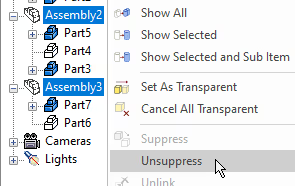
For an assembly, three additional options are added;
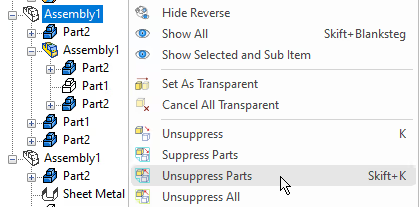
Suppress Parts
Suppresses all parts in an assembly in all levels. NOTE! If a sub-assembly contains only one part, the assembly will also be suppressed due to missing content.
Unsuppress Parts
Only brings up the parts that are suppressed in the structure below the compilation. If there are individual assemblies that have been suppressed via Suppress , these will not be visible again. NOTE! These suppressed assemblies and all their contents remain hidden in the 3D scene.
Unsuppress All
Turns on all items that are suppressed in the assembly.
Suppress vs Hide - what's the difference?
The Suppress function is meant to be used for items that should be hidden more permanently over time, while the Hide function is a more temporary solution when things are in the way and should be quickly removed and then just as quickly brought out again.
Its keyboard shortcuts are different combinations of the space/blank key that, when used properly, give you more control in the 3D scene!

Configurations only use Suppress
When working with configurations, Suppress is used as the permanent way to hide items in a given configuration.
The 2D drawing uses both Suppress and Hide, but in completely different ways
Suppress is also reflected in the 2D drawing, where the object disappears from both views and parts list, while Hide has no such effect at all on the 2D drawing.
However, with the 2D drawing, you can use the Select Assembly to Project function to select individual objects to be depicted in a drawing view. You can also use the Hide function to hide objects in the 3D scene, which means that the 2D drawing "actively ignores" the objects that are hidden via Hide. This has nothing to do with the objects not being visible in the 3D scene, but that the views are instructed to actively not depict these objects.
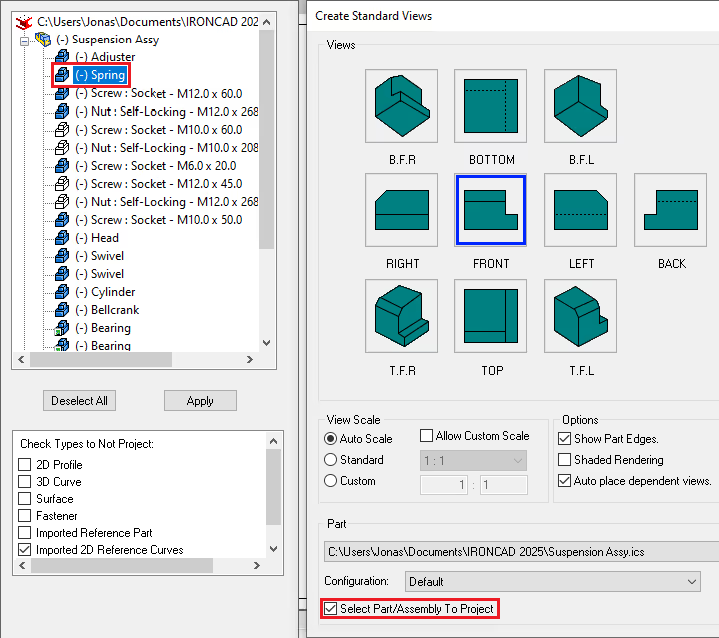
Ghost
The Ghost function is a kind of reference function that means that a part or assembly is displayed transparently and can no longer be clicked on with the mouse pointer or snapped against with handles from other objects or with TriBall etc.
Activate Ghost using the keyboard shortcut [G] or via the Tools tab. There are also options for managing the objects that are already set as Ghost.
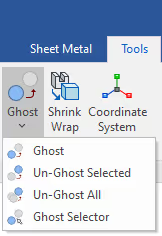
The control for the transparency of an object set as Ghost and whether it should be possible to snap to it is controlled via Options, Part (at the bottom).

Answer: Here we publish tips, guides, news and solutions for those who work with IRONCAD and Design Data Manager (DDM). The blog covers everything from basic functions to advanced workflows, helping you to optimize your design work. You'll find examples of smart shortcuts, practical instructions, solutions to common problems, and best practices for product design, mechanical design, and product data management.
Answer: Our guides and tips are designed for both beginners and experienced CAD users. They are aimed at designers, engineers and project managers who want to work more efficiently with IRONCAD and DDM, improve the design process, reduce mistakes and save time in product development.
Answer: We regularly publish new articles when the software is updated, when new features are introduced, or when our users ask for solutions to specific problems. The blog is therefore a reliable source for keeping up to date and getting tips that make everyday CAD work easier.
Answer: Many of our instructions and tips work in multiple versions, but we clearly indicate if an article applies to a specific version. We strive to make the content useful for older versions as well, and also provide recommendations on how to adapt workflows to the version you are using.
Answer: Absolutely! If you can't find the solution in the blog, you can contact our technical support via solidmakarna.support. Our experts will help you with everything from installation and configuration to advanced features in IRONCAD and DDM, so you can solve problems quickly and efficiently.
Answer: Yes! We appreciate suggestions from our users. If you have questions, tips or want us to address a specific issue in IRONCAD or DDM , please contact us via our contact form and we will prioritize relevant topics in future posts.
Answer: The blog contains, among other things:
Practical step-by-step guides to help you use IRONCAD and DDM more effectively.
Productivity and workflow tips for faster design and construction.
Solutions to common problems encountered by users in CAD programs.
Updates and news on new features, versions and improvements.
Best practices for data management and project organization in DDM.
Answer: All tips and guides are directly applicable in daily work. For example, you can use shortcuts and smart features in IRONCAD to speed up modeling, structure files better in Design Data Manager, or follow our step-by-step solutions for specific problems that often come up in design projects.
Answer: We strive to ensure that all guides and tips are relevant to the latest versions of IRONCAD and DDM. We also clearly mark when a post applies to an older version, so you always know if the instruction is directly applicable to your system.
Answer: Yes! Many of our users share the articles with colleagues and use them as internal training materials. The blog is a great complement to formal training and helps teams learn features faster, avoid mistakes, and standardize workflows in IRONCAD and DDM.